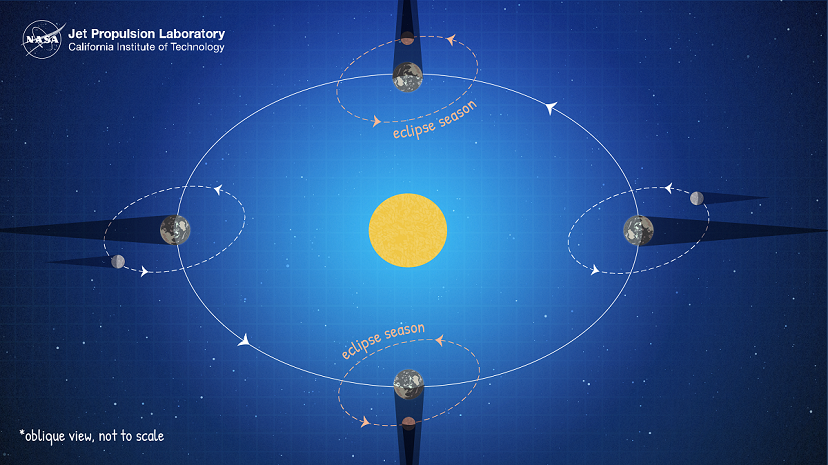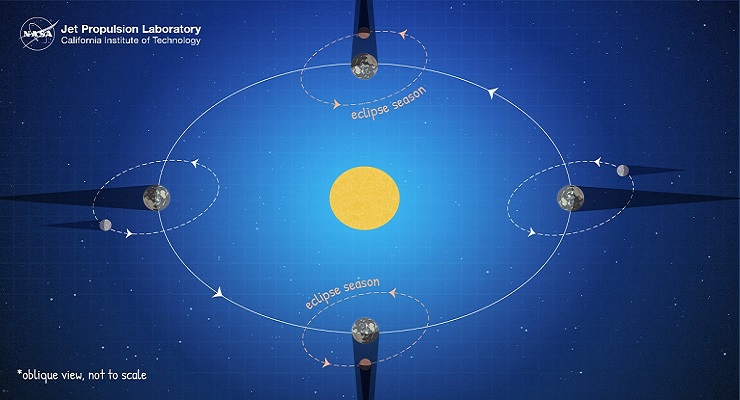
When the total lunar eclipse occurs on January 31, it will be the only total lunar eclipse visible from North America this 2018, and it would help a lot if you knew where to be and what time to position yourself to enjoy the view.
A second total lunar eclipse for 2018 occurs on July 27, but this will not be visible in the United States because it will be daytime, and the moon will be below the horizon when the event happens.
People on the U.S. West Coast, including Pasadena, will be able to see the whole total phase of the January 31 eclipse, which starts at 3:48 a.m. PST. The moon will start to pass out of the umbra at 6:07 a.m. and will set at 6:54 a.m., before it fully emerges from the umbral shadow.
The Jet Propulsion Laboratory (JPL) in Pasadena last week published an article explaining why total lunar eclipses occur and how best to view them.
“Eclipses can occur when the Sun, the Moon and Earth align,” the article said. “Lunar eclipses can only happen during the full moon phase, when the Moon and the Sun are on opposite sides of Earth. At that point, the Moon could move into the shadow cast by Earth, resulting in a lunar eclipse. However, most of the time, the Moon’s slightly tilted orbit brings it above or below the shadow of Earth.”
During a lunar eclipse, the Moon passes through two distinct parts of Earth’s shadow. The outer part of the cone-shaped shadow is called the penumbra. The penumbra is less dark than the inner part of the shadow because it’s penetrated by some sunlight. The inner part of the shadow, known as the umbra, is much darker because Earth blocks additional sunlight from entering the umbra.
The JPL article said the January 31 eclipse is doubly interesting because it takes place when the full moon is at or near the closest point in its orbit to Earth; when this happens, the moon is popularly known as a “supermoon.” This means the moon is deeper inside the umbra shadow and therefore may appear darker.
And because the eclipse happens during the second full moon in a month – a blue moon – Space.com is calling the phenomenon a “Super Blue Blood Moon” eclipse.
Unlike solar eclipses – eclipses of the sun – which require special glasses to view and can only be seen for a few short minutes in a very limited area, a total lunar eclipse can be seen for about an hour by anyone on the nighttime side of Earth – as long as skies are clear.
For viewers in the West Coast, the JPL article mentioned the critical phases of the January 31 lunar eclipse, and what times these phases take place that day.
At 2:51 a.m. PST on January 31, the edge of the Moon will begin entering the penumbra. The Moon will dim very slightly for the next 57 minutes as it moves deeper into the penumbra. Because this part of Earth’s shadow is not fully dark, you may only notice some dim shading (if anything at all) on the Moon near the end of this part of the eclipse.
At 3:48 a.m. PST, the edge of the Moon will begin entering the umbra. As the Moon moves into the darker shadow, significant darkening will be noticeable. Some say that during this part of the eclipse, the Moon looks as if it has had a bite taken out of it. That “bite” gets bigger and bigger as the Moon moves deeper into the shadow.
At 4:51 a.m. PST, the Moon will be completely inside the umbra, marking the beginning of the total lunar eclipse. The moment of greatest eclipse, when the Moon is halfway through the umbra, occurs at 5:31 a.m. PST.
As the Moon moves completely into the umbra, something interesting happens: The Moon begins to turn reddish-orange. The reason for this phenomenon is that as sunlight passes through Earth’s atmosphere, the small molecules in the atmosphere scatter blue light, which makes the sky appear blue. This leaves behind mostly red light that bends, or refracts, into Earth’s shadow. That red light can be seen during an eclipse as it falls onto the Moon in Earth’s shadow. This same effect is what gives sunrises and sunsets a reddish-orange color.
At 6:07 a.m. PST, the edge of the Moon will begin exiting the umbra and moving into the opposite side of the penumbra. This marks the end of the total lunar eclipse.
At 7:11 a.m. PST, the Moon will be completely outside of the umbra. It will continue moving out of the penumbra until the eclipse ends at 8:08 a.m.

















